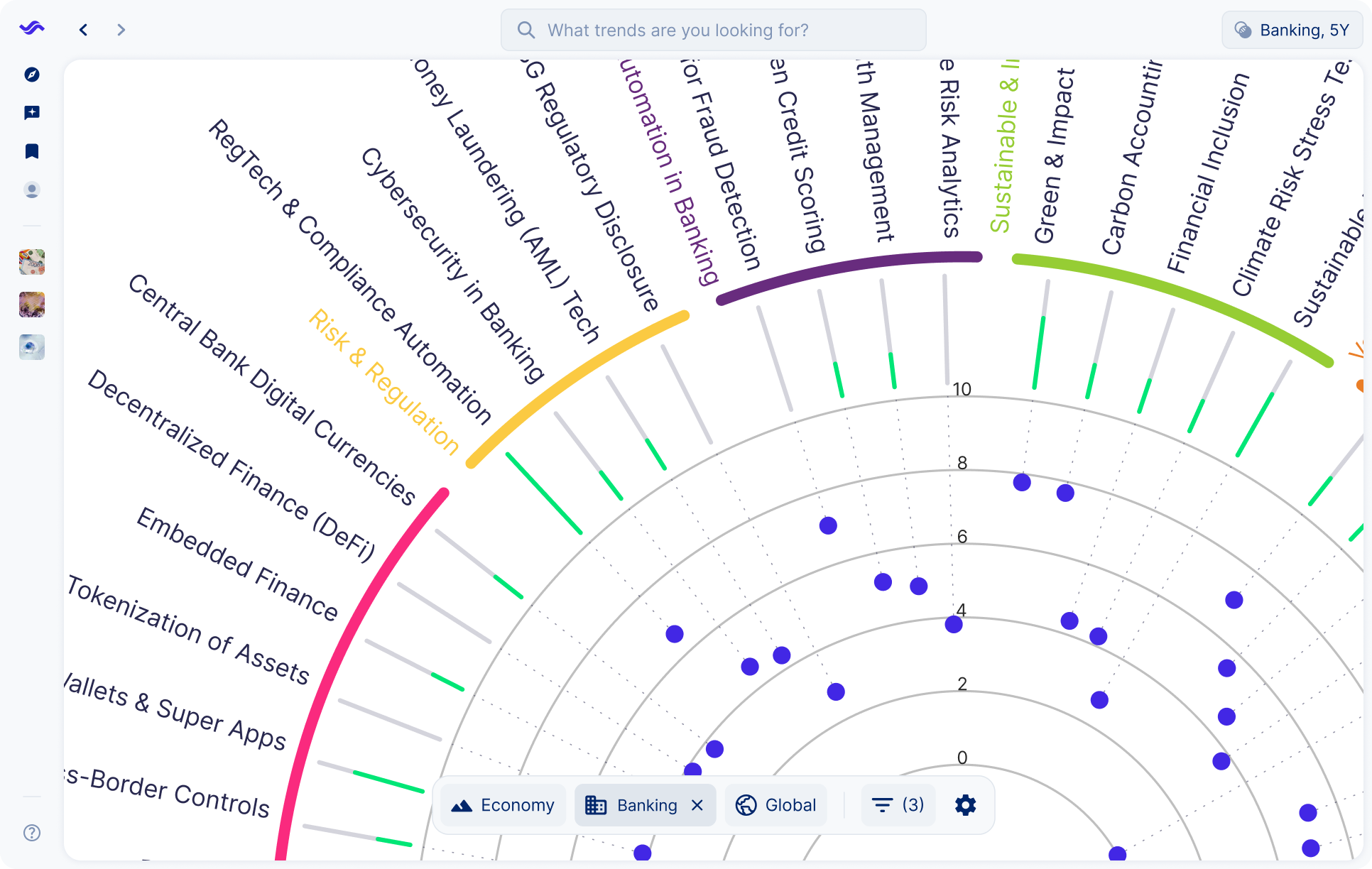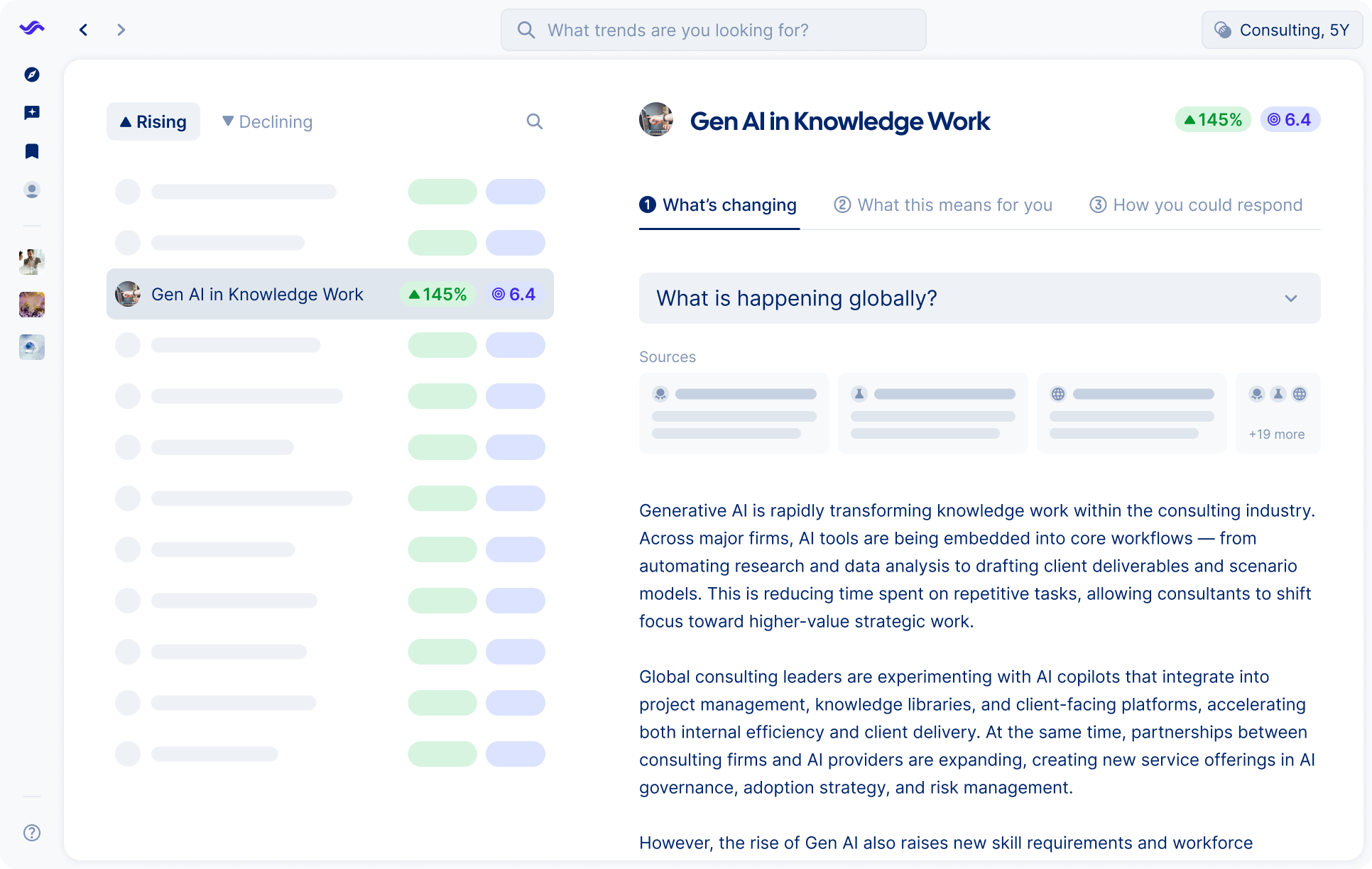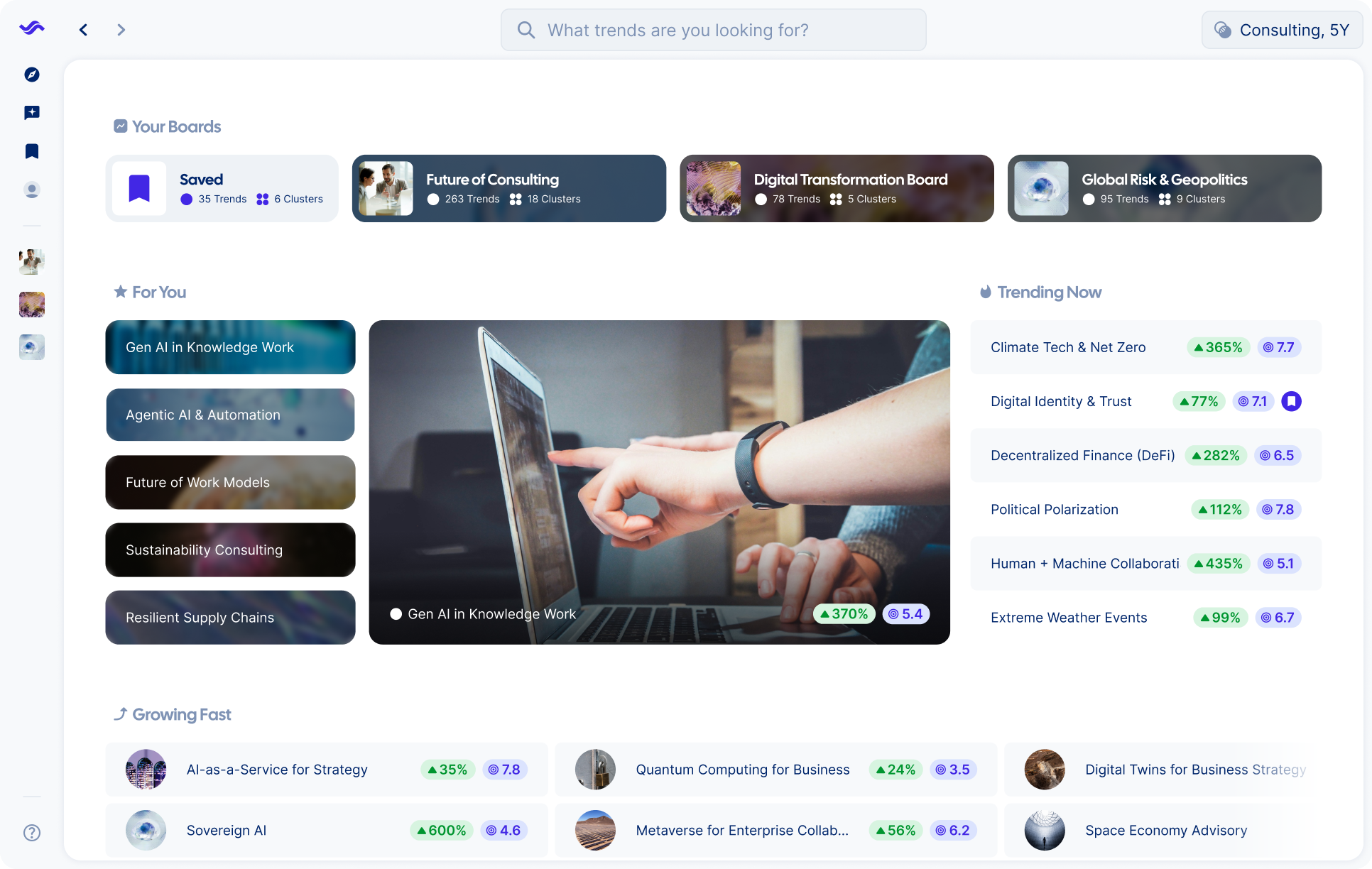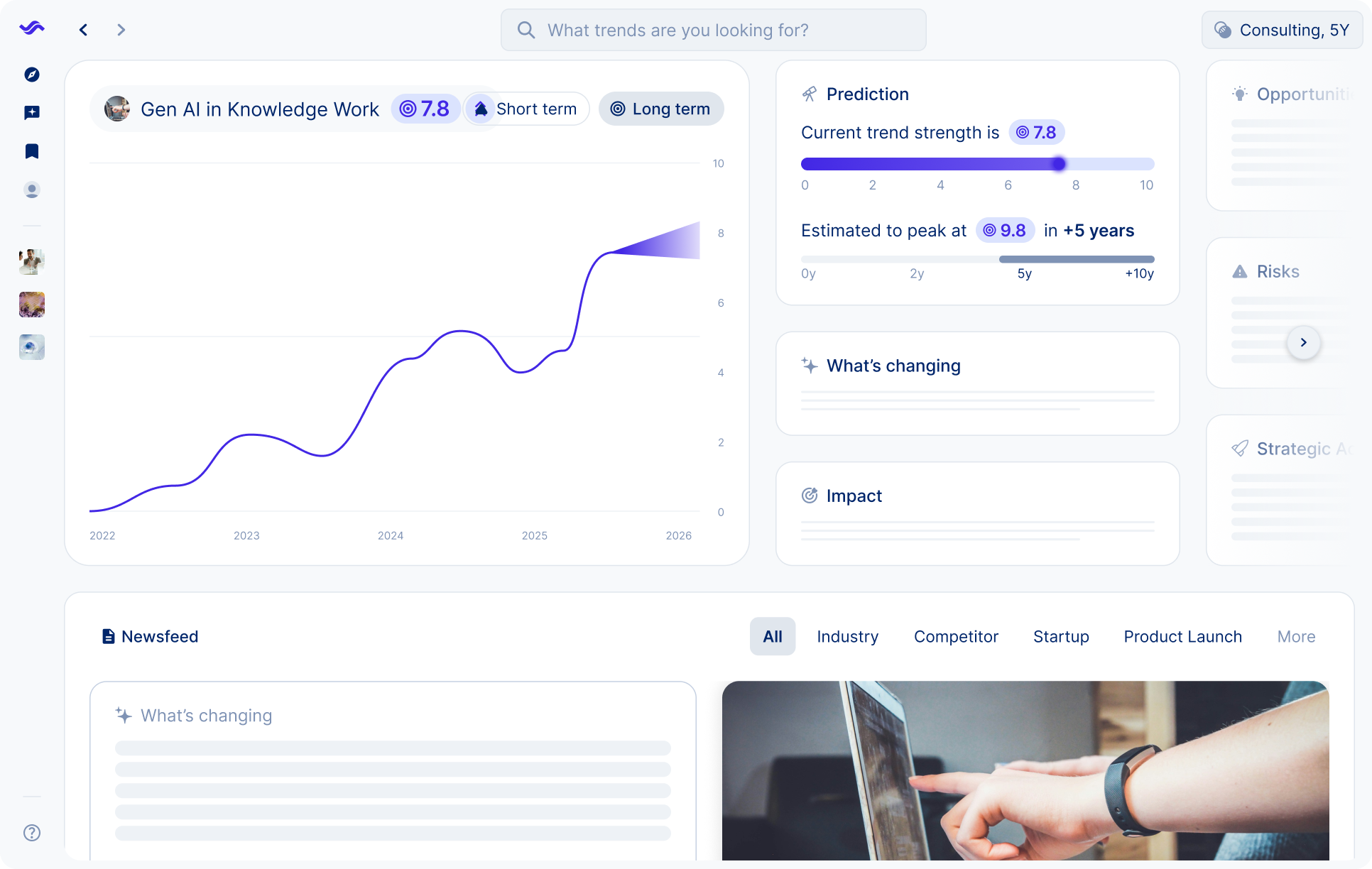

Problems
Our solution





See your strategic landscape clearly
AI Analyst for consulting leaders
Spot opportunities sooner than anyone else
Track trends in real time
Key benefits
Strategists trust Trendtracker to turn data overload into instant, actionable insights.
Trends in the industry


Consulting firms are rapidly adopting generative AI to automate research, analyze vast data sets, and draft client deliverables. Global demand is rising as clients expect faster, more tailored insights. While adoption is expanding quickly, firms are still learning how to balance efficiency with quality and confidentiality.
Generative AI is reshaping the core of consulting. It changes the economics of projects, influences how firms charge for services, and pressures consultants to shift toward higher value advisory. Firms that fail to adapt risk losing relevance as AI levels the playing field.
Consultancies can integrate AI into delivery processes, retrain teams to focus on advanced problem solving, and develop proprietary AI tools to differentiate their services. Transparency around data use and clear communication with clients will be critical for building trust.
.jpg)
.jpg)
Clients across industries are under pressure from regulators and investors to demonstrate ESG progress. This is fueling strong demand for consulting support in areas like decarbonization, carbon credits, and sustainability reporting.
Sustainability is moving from a side service to a central growth driver for consultancies. Firms that offer credible ESG expertise and measurable impact will gain competitive advantage, while those that cannot adapt risk being sidelined in client transformation journeys.
Consultancies should build specialized ESG practices, invest in sustainability data platforms, and partner with regulators and NGOs. Clear measurement frameworks and transparent client reporting will strengthen credibility and unlock long term opportunities.


Consulting firms are experimenting with digital platforms that offer subscription based insights, benchmarking tools, and on demand access to expertise. This reflects growing client demand for continuous support rather than one off projects.
The traditional billable hour model is being challenged. Platform based consulting creates recurring revenue streams, scales expertise, and enhances resilience against market cycles. It also changes client expectations toward more digital and data driven engagements.
Firms should pilot subscription services, develop digital ecosystems, and invest in scalable knowledge platforms. Embracing these models will require cultural change, but it positions consultancies for sustainable growth in a competitive environment.
Want to discover, analyse and forecast trends within the consulting industry? See how Trendtracker’s AI turns information overload into instant, actionable clarity for consultant professionals.
The consulting sector is at a turning point. Clients expect faster, data-driven insights, measurable impact, and support in navigating sustainability and technology transitions. Traditional models built on billable hours and bespoke reports are giving way to new approaches that blend human expertise with AI, platforms, and purpose-driven advisory. Firms that adapt quickly will not only protect margins but also open new paths for growth.
Generative AI and advanced analytics are transforming the consulting toolkit. Research, data crunching, and even first drafts of deliverables can now be automated, forcing firms to rethink how value is created and priced.
Today’s landscape
Firms are embedding generative AI into research, analysis, and client deliverables. Tasks that once took days are now done in hours, pushing consultancies to reconsider their pricing and staffing models.
The road ahead
Generative AI will push firms to focus less on producing slides and more on delivering unique insights. Clients will expect faster turnaround at lower cost, and competition will intensify as AI narrows the gap between large firms and smaller challengers.
PESTLE: Technological (Tech), Economic (Econ), Social (S)
Horizon: Near- to mid-term (0–5y)
Strategic action: Redesign value propositions around insight and impact, invest in proprietary AI tools, and retrain consultants to focus on creative problem solving.
Today’s landscape
Traditional desk research is giving way to real-time data platforms and AI-powered foresight. Firms that once relied on analysts to manually compile insights are now offering continuous monitoring of markets and disruptions.
The road ahead
Clients will expect “always-on” intelligence rather than one-off reports. Consulting firms will need to integrate data platforms and foresight tools into their core offerings to stay relevant.
PESTLE: Technological (Tech), Political/Legal (P/L), Economic (Econ)
Horizon: Mid-term (5–10y)
Strategic action: Partner with data providers, embed foresight platforms into workflows, and ensure transparency in methodologies to build trust.
Today’s landscape
Automation is taking over repetitive tasks like data cleaning, benchmarking, and basic reporting. This is freeing up time but also raising questions about billing models and consultant roles.
The road ahead
Consultants will need to shift toward higher-value advisory, focusing on strategy, storytelling, and change management. The firms that successfully reposition their talent will win client trust and sustain margins.
PESTLE: Social (S), Technological (Tech), Economic (Econ)
Horizon: Near- to mid-term (0–5y)
Strategic action: Develop training programs to reskill staff, adjust pricing models to reflect value delivered, and emphasize the human side of transformation that AI cannot replace.


Clients are under mounting pressure to prove progress on climate, ethics, and social impact. They need advisors who combine credible expertise with execution. This is moving ESG from a slide in the deck to a core line of business for consulting firms.
Today’s landscape
Boards want targets that stand up to investor and regulator scrutiny. Many firms still have high-level pledges without the roadmap, data, or governance to deliver.
The road ahead
Expect a shift from generic playbooks to sector-specific pathways with measurable outcomes and third-party assurance.
PESTLE: Political/Legal, Economic, Social, Technological
Horizon: Near- to mid-term (0–5 years)
Strategic action: Build sector ESG playbooks with clear metrics. Stand up a verification partner network for audit-ready evidence. Train client teams so progress survives leadership changes.
Today’s landscape
Carbon exposure is now a financial risk. Leaders want to know which assets to retire, which to retrofit, and which new technologies to back.
The road ahead
Decarbonization becomes investment strategy. Capital allocation will follow abatement curves and transition finance opportunities.
PESTLE: Environmental, Economic, Political/Legal, Technological
Horizon: Mid-term (3–8 years)
Strategic action: Offer abatement curve modeling, CapEx reprioritization, and supplier transition programs. Link plans to financing options and incentive regimes.
Today’s landscape
Reporting rules are tightening. Clients struggle with data quality, scope-3, and fragmented standards.
The road ahead
Disclosure becomes continuous. Automation and assurance will be expected, not optional.
PESTLE: Political/Legal, Technological, Economic
Horizon: Near-term (0–3 years)
Strategic action: Deploy data pipelines and controls that map to major frameworks. Package “report-once, disclose-many” operating models and embed internal audit by design.

The traditional model of bespoke projects billed by the hour is under strain. Clients want faster answers, continuous access to insights, and scalable solutions. Consulting firms are responding by creating digital platforms, subscription services, and benchmarking tools that turn knowledge into recurring revenue.
Today’s landscape
Some firms now package insights and dashboards as subscription products. This reduces dependence on one-off projects while giving clients continuous value.
The road ahead
Subscription-based advisory will expand, blending digital access with periodic expert support. This will challenge pricing models but create steadier revenue.
PESTLE: Economic, Technological, Social
Horizon: Near- to mid-term (0–5 years)
Strategic action: Pilot subscription offerings in niches with repeat demand. Link platform access to advisory packages, and shift sales teams to emphasize lifetime value.
Today’s landscape
Clients can already hire experts by the hour via digital platforms. This challenges traditional firms that rely on long projects to deploy teams.
The road ahead
On-demand models will spread into mainstream consulting. Firms that ignore them risk disintermediation as clients build direct expert networks.
PESTLE: Technological, Economic, Social
Horizon: Mid-term (3–7 years)
Strategic action: Develop curated expert marketplaces under the firm’s brand. Combine freelance capacity with proprietary methods to keep client stickiness.
Today’s landscape
Benchmarking once relied on custom surveys. Now digital tools allow real-time comparisons across industries, functions, and geographies.
The road ahead
Clients will expect ongoing benchmarking as a baseline service. Static surveys will give way to automated, data-driven insights that refresh continuously.
PESTLE: Technological, Economic, Political/Legal
Horizon: Near- to mid-term (0–5 years)
Strategic action: Invest in proprietary benchmarking databases. Design client dashboards that combine automated comparisons with tailored advisory.
